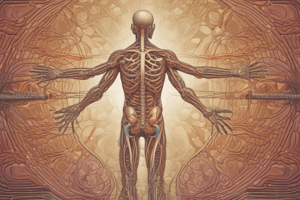Podcast
Questions and Answers
Explain the importance of homeostasis in maintaining physiological functions.
Explain the importance of homeostasis in maintaining physiological functions.
Homeostasis is crucial as it maintains a stable internal environment, allowing cells to function optimally.
What is the role of the autonomic nervous system in physiological regulation?
What is the role of the autonomic nervous system in physiological regulation?
The autonomic nervous system regulates involuntary bodily functions like heart rate, digestion, and respiratory rate.
Describe the relationship between structure and function in the cardiovascular system.
Describe the relationship between structure and function in the cardiovascular system.
In the cardiovascular system, the structure of blood vessels (like their elasticity and diameter) directly impacts blood flow and pressure.
How do feedback mechanisms contribute to physiological changes in the body?
How do feedback mechanisms contribute to physiological changes in the body?
Discuss the significance of cellular signaling in maintaining organ function.
Discuss the significance of cellular signaling in maintaining organ function.
Flashcards are hidden until you start studying
Study Notes
Homeostasis and Physiological Function
- Homeostasis is the maintenance of a stable internal environment, essential for optimal cell function and survival.
- Variations in external conditions can disrupt internal balance, requiring physiological responses to restore homeostasis.
- Negative feedback mechanisms are crucial for maintaining homeostasis, counteracting changes and restoring equilibrium.
Autonomic Nervous System (ANS) in Physiological Regulation
- The ANS regulates involuntary bodily functions, controlling processes like heart rate, breathing, digestion, and blood pressure.
- It operates without conscious control, maintaining homeostasis in response to internal and external stimuli.
- The ANS consists of two divisions:
- Sympathetic nervous system prepares the body for "fight-or-flight" responses, increasing heart rate, respiration, and blood pressure.
- Parasympathetic nervous system promotes "rest-and-digest" functions, slowing heart rate and promoting digestion.
Structure and Function in the Cardiovascular System
- The cardiovascular system comprises the heart, blood vessels, and blood, working together to transport oxygen, nutrients, and waste products throughout the body.
- The heart, a muscular pump, propels blood through the circulatory system.
- Blood vessels, including arteries, veins, and capillaries, form a network for blood flow.
- Arteries carry oxygenated blood away from the heart, while veins return deoxygenated blood to the heart.
- Capillaries facilitate exchange of gases, nutrients, and waste products between blood and tissues.
Feedback Mechanisms and Physiological Changes
- Feedback mechanisms are essential for regulating physiological processes and maintaining homeostasis.
- Negative feedback is the most common type, where a change in a regulated variable triggers a response that opposes the initial change.
- Positive feedback amplifies the initial change, often leading to rapid and dramatic effects.
Cellular Signaling in Maintaining Organ Function
- Cellular signaling involves communication between cells, essential for coordinating activities within organs and throughout the body.
- Signals can be chemical (hormones, neurotransmitters) or physical (mechanical pressure, temperature).
- Cells possess receptors specific for certain signals, triggering intracellular pathways that influence cellular behavior.
- Cell signaling underlies a wide range of physiological processes, including growth, metabolism, and immune responses.
Studying That Suits You
Use AI to generate personalized quizzes and flashcards to suit your learning preferences.




